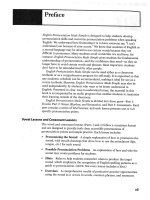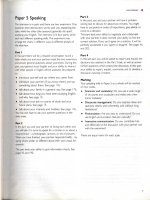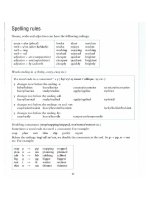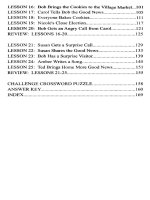Asignment practise english 2 pps
Bạn đang xem bản rút gọn của tài liệu. Xem và tải ngay bản đầy đủ của tài liệu tại đây (66.62 KB, 6 trang )
Directions: Questions 31–35 are based on the following passage, a first draft of an essay about the history of bicy-
cles. Read the passage and the questions that follow. For each question, choose the answer that will most improve
the passage. Some questions ask you to choose the best revision of a particular sentence or pair of sentences. Other
questions ask you to consider how to best improve the overall organization of the passage. In each case, the cor-
rect answer is the one that most closely conforms to the conventions of formal writing.
(1)Today, bicycles are so common it’s hard to believe they haven’t always been around. (2)But two hundred years
ago, bicycles weren’t even existing, and the first bicycle, invented in Germany in 1818, was nothing like our bicy-
cles today—it was made of wood and didn’t even have pedals. (3)Since then, however, numerous innovations and
improvements in design have made the bicycle one of the most popular means of recreation and transportation
around the world.
(4)In 1849, James Starley, an English inventor, made the front wheel many times larger than the back
wheel, put a gear on the pedals to make the bicycle more efficient, and lightened the wheels by using wire spokes.
(5)Although this bicycle was much lighter and less tiring to ride, it was still clumsy, and ridden mostly for enter-
tainment. (6)In 1839, Kirkpatrick Macmillan a Scottish blacksmith dramatically improved upon the original bicy-
cle design, employing tires with iron rims to keep them from getting worn down. (7)But the back wheel was
substantially larger than the front wheel.
(8)Another Englishman, H.J. Lawson, invented the “safety bicycle,” which had equal sized wheels that were
less prone to toppling over. (9)Lawson also attached a chain to the pedals to drive the rear wheel. (10)As the bicy-
cle improved over time, its popularity grew and it became useful for transportation.
–PRACTICE TEST 3–
145
31. Which of the following is the best way to revise
the underlined portion of sentence 2?
(2)But two hundred years ag
o, bicycles weren’t even
existing, and the first bicycle, invented in Germany
in 1818, was nothing like our bicycles today—it was
made of wood and didn’t even have pedals.
a. ago, there were no existing bicycles,
b. ago, bicycles weren’t even around,
c. ago bicycles weren’t even existing
d. ago, bicycles didn’t exist,
e. ago bicycles didn’t exist
32. What is the most logical information, in context,
to add before sentence 8?
a. In France at that time, other inventions were
being made.
b. The English were quite ready now to really
improvement the bicycle.
c. Bicycles began to be used for transportation at
this time.
d. It didn’t matter which tire was larger, the front
or the back.
e. It wasn’t until 1874 that the first truly modern
bicycle appeared on the scene.
33. What is the best order of sentences for paragraph 2?
a. 4, 5, 6, 7
b. 6, 7, 5, 4
c. 6, 7, 4, 5
d. 4, 5, 7, 6
e. 4, 6, 7, 5
34. Considering the context of the passage, which of
the following sentences is best to insert between
sentences 9 and 10?
a. These innovations made it easier to ride.
b. Lawson and his family made the bicycle a bet-
ter machine.
c. It was Lawson who finally made the bicycle a
two-wheeled machine.
d. The English finally perfected the machine they
invented over a hundred years earlier.
e. No additional sentence is needed.
35. What is the best title for the passage?
a. From Germany to England: Europe’s Exciting
Inventions
b. Two Hundred Years of Cycling History
c. The Development of the Modern Bicycle
d. The Bicycle: Big Wheels to Small Wheels
e. Recreational Uses of the Bicycle
–PRACTICE TEST 3–
146
Section 3
Time: 10 minutes
14 multiple-choice questions
ANSWER SHEET:
–PRACTICE TEST 3–
147
1.abcde
2.abcde
3.abcde
4.abcde
5.abcde
6.abcde
7.abcde
8.abcde
9.abcde
10.abcde
11.abcde
12.abcde
13.abcde
14.abcde
all of the sentence is underlined. The underlined text
may contain an error in sentence construction, gram-
mar, word choice, or punctuation. Choice a repeats
the original underlined text. If there is no error in the
underlined portion, choose a. If there is an error, select
the answer choice that most effectively expresses the
meaning of the sentence without any ambiguity or
awkwardness.
1. The American Begonia Society publishes a bi-
monthly journal called the B
egonian, and main-
tain a virtual greenhouse on their website for
those interested in the plant family Begoniacea.
a. Begonian, and maintain a virtual greenhouse
on their website
b. Begonian; they also maintain what they call a
virtual greenhouse on their website
c. Begonian, and maintains a virtual greenhouse
on their website
d. Begonian. The Society maintains a greenhouse
that is virtual on their own website
e. Begonian, and on their website a virtual
greenhouse is maintained
2. The history of ice cream is subject to an erro-
neous legend that Dolly Madison introduced it
to America at a White House reception d
uring
he
r husband’s administration but in fact it was
alr
eady popular in cities such as Phila
delphia and
N
ew York.
a. during her husband’s administration but in
fact it was already popular in cities such as
Philadelphia and New York.
b. during her husband’s administration, in fact it
was already popular in cities such as Philadel-
phia and New York.
c. during her husband’s administration; it was
already popular in cities such as Philadelphia
and New York.
d. during her husband’s administration. In fact it
was already popular in cities such as Philadel-
phia and New York.
e. during her husband’s administration. There-
fore it was already popular in cities such as
Philadelphia and New York.
3. T
he dating of the great Sphinx at Giza became
c
ontroversial between Egyptologists after John
Anthony West espoused his theory that the ero-
sion on the Sphinx was caused by water, and not
blowing sand as was previously believed.
a. The dating of the great Sphinx at Giza became
controversial between Egyptologists
b. The dating of the great Sphinx that is in Giza
became controversial between Egyptologists
c. The dating of the great Sphinx at Giza became
controversial among Egyptologists
d. The dating of the great Sphinx at Giza is
becoming controversial among Egyptologists
e. The dating of the great Sphinx at Giza has
become controversial among Egyptologists
–PRACTICE TEST 3–
149
4. Although more than 95% of earthquakes occur
in plate marg
ins (meaning areas in which plates
separate, grind past each other, or collide), New
York State has experienced over 400 earthquakes
in the past two centuries and it is not near any
plate margins.
a. margins (meaning areas in which plates sepa-
rate, grind past each other, or collide),
b. margins, which are simply areas in which
plates separate, or they might grind past each
other, or they could collide,
c. margins (“margins” here refers to areas in
which plates separate, grind past each other,
or collide),
d. margins (meaning those areas in which plates
of the earth’s crust separate, grind past each
other, or collide),
e. margins. Margins are areas in which plates
separate, grind past each other, or collide.
5. A
ccording to the Barbecue Industry Association,
three out of four U.S. households own a barbe-
cue grill, more than half of all Americans use
their grills year-round, and over 60% of barbe-
cuers wer
e men.
a. According to the Barbecue Industry Associa-
tion, three out of four U.S. households own a
barbecue grill, more than half of all Ameri-
cans use their grills year-round, and over 60%
of barbecuers were men.
b. According to the Barbecue Industry Associa-
tion, there are three out of four U.S. house-
holds that own a barbecue grill, more than
half of all Americans use their grills year-
round, and over 60% of barbecuers were men.
c. According to the Barbecue Industry Associa-
tion, there are three out of four U.S. house-
holds that own a barbecue grill, more than
half of all Americans use their grills year-
round, and over 60% of barbecuers are men.
d. The Barbecue Industry Association reports
that three out of four U.S. households own a
barbecue grill, more than half of all Ameri-
cans use their grills year-round, and over 60%
of barbecuers were men.
e. According to the Barbecue Industry Associa-
tion, three out of four U.S. households own a
barbecue grill, more than half of all Ameri-
cans use their grills year-round, and over 60%
of barbecuers are men.
–PRACTICE TEST 3–
150









